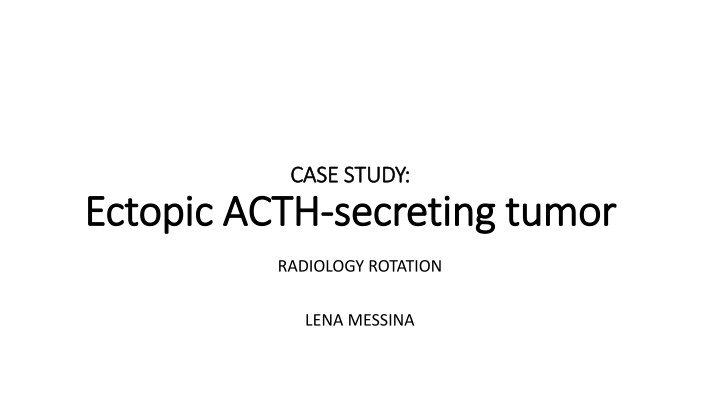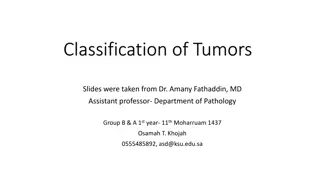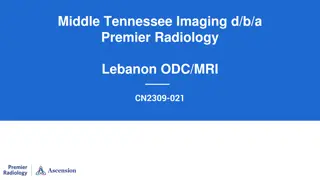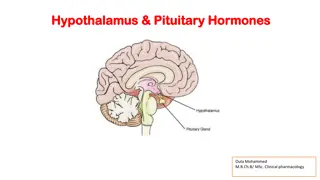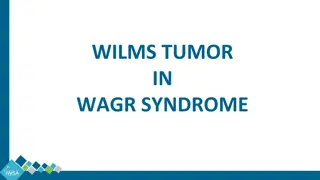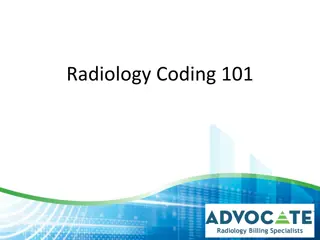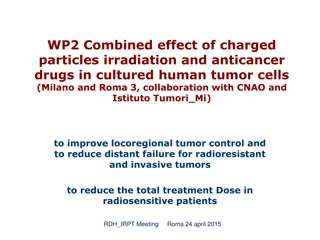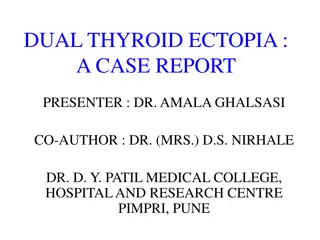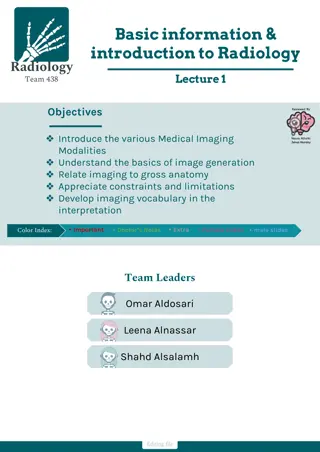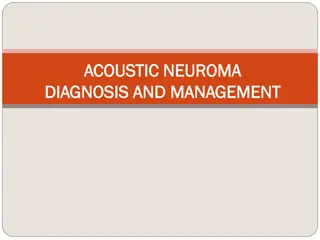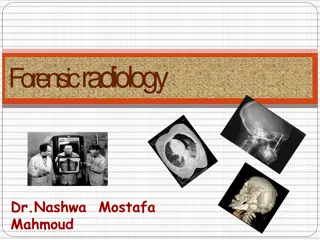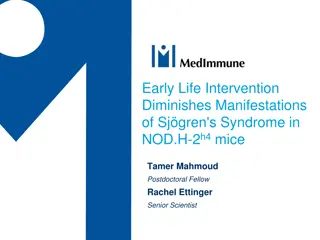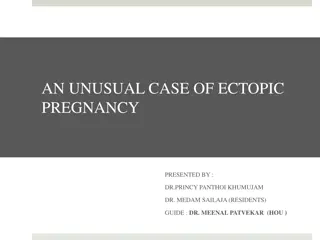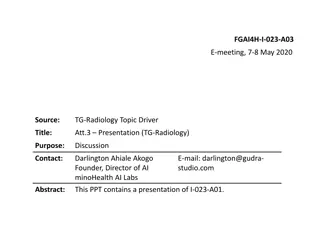Ectopic ACTH-Secreting Tumor: Radiology Findings
A 38-year-old African American female presents with hypokalemia secondary to Cushing's syndrome. Clinical manifestations include weight gain, amenorrhea, and hyperpigmentation. Imaging reveals a pituitary microadenoma and hepatic mass, suggestive of a neuroendocrine neoplasm. Further evaluation for primary carcinoid tumor is recommended. This comprehensive case study highlights the diagnostic journey in managing an ectopic ACTH-secreting tumor.
Download Presentation

Please find below an Image/Link to download the presentation.
The content on the website is provided AS IS for your information and personal use only. It may not be sold, licensed, or shared on other websites without obtaining consent from the author.If you encounter any issues during the download, it is possible that the publisher has removed the file from their server.
You are allowed to download the files provided on this website for personal or commercial use, subject to the condition that they are used lawfully. All files are the property of their respective owners.
The content on the website is provided AS IS for your information and personal use only. It may not be sold, licensed, or shared on other websites without obtaining consent from the author.
E N D
Presentation Transcript
CASE STUDY: CASE STUDY: secreting tumor Ectopic ACTH Ectopic ACTH- -secreting tumor RADIOLOGY ROTATION LENA MESSINA
Subjective: Pt is a 38 y.o. African American F with no significant PMH admitted to General Medicine with hypokalemia 2/2 to Cushing s syndrome. She reports progressive swelling, weight gain and acne over the course of the past year. She has been amenorrhoeic for >6 months. Earlier labs showed hypothyroidism and hyperprolactinemia and the patient was started on levothyroxine and bromocriptine. She had multiple prior admissions for hypokalemia. She denies headaches, vision changes or urinary symptoms. No family history of cancer, including pancreatic and pituitary tumors Former tobacco user for 20 years. Married with two children.
Objective: BP: 161/81 (no prior history of hypertension) BMI: 34.97 (Weight 185 lbs, 30 lb gain over past year, Height 5 0) PE notable for: round face, facial hair, hyperpigmented buccal mucosa, rash on face, chest and upper extremities, hyperpigmentation of palmar creases, violaceous striae on abdomen LABS: K 2.3 (L) Ref: 3.4-4.8 mmol/L Cortisol 92.8 (H), 80.1 after 8 mg Dexamethasone ACTH: 417 (H) Ref: 9-52 pg/mL Gastrin: 1717 (H) Ref: 0-100 pg/mL 5-HIAA 24 hr: 54 (H)
Pituitary MRI (concern for ACTH secreting tumor): -Hypoenhancing region within the far anterior central aspect of the pituitary gland measuring 3.0 x 1.8 mm possibly represents a pituitary microadenoma.
CT chest: 1. Multiple hepatic nodules and large dominant heterogeneously enhancing right hepatic mass (9.1x7.2 cm). In the setting of Cushing syndrome this likely represents an intra-abdominal neuroendocrine neoplasm either primary or metastatic to the liver. Referred to same day abdominal MRI, not yet to performed at the time of final interpretation of this study. 2. No evidence of intrathoracic primary or metastatic neoplastic disease.
MRI Abdomen: MRI Abdomen: Numerous hypervascular liver masses in the setting of patient's symptoms is most suspicious for carcinoid primary. This may be primary to the liver or metastatic. No small bowel mass or mesenteric mass is visualized although remains within the differential. Biopsy recommended of the liver lesions to confirm diagnosis of carcinoid. Once the diagnosis is confirmed, consider octreotide scan to assess for site of primary tumor not visualized on this exam.
Additional studies: US guided Liver biopsy: Neoplastic cells immunoreactive to chromogranin, synaptophysin, cytokeratin and ACTH. Consistent with Grade 1 neuroendocrine carcinoma. EGD: non-contributory, BX of gastric mucosa: normal
Review of pathology suggestive of low grade well differentiated neuroendocrine carcinoma. Primary tumor is usually located in duodenum, pancreas and abdominal lymph nodes, but other ectopic locations have been described (heart, ovary, gallbladder, liver, kidney). Not identified in our patient. Her tumor is a functional carcinoid secreting ACTH interfering with HPA.
Follow up Extent of liver lesions precluded resection. Octreotide scan was not performed as it was not going to change management. Pt. started on long acting octreotide. Cushing s syndrome managed with ketoconazole, spironolactone and K replacement as outpatient She returned to UVA later for embolization of her liver lesions. Currently, the largest lesion is approximately the original size This is a rare case, but a similar one was reported in 2008 in Jacksonville, FL (Coe, Susan G., Winston W. Tan, and Thomas P. Fox. Cushing s Syndrome Due to Ectopic Adrenocorticotropic Hormone Production Secondary to Hepatic Carcinoid: Diagnosis, Treatment, and Improved Quality of Life. Journal of General Internal Medicine 23.6 (2008): 875 878.)
